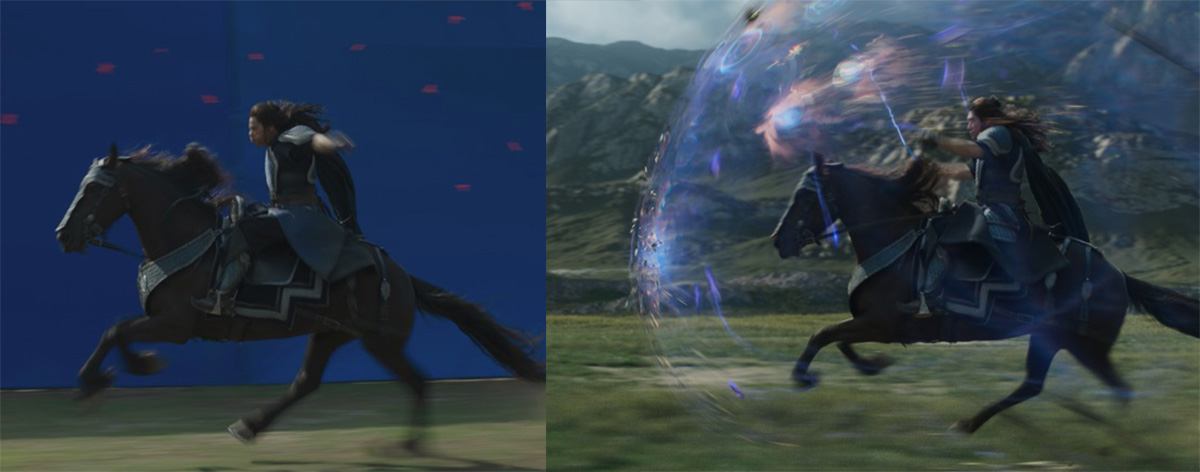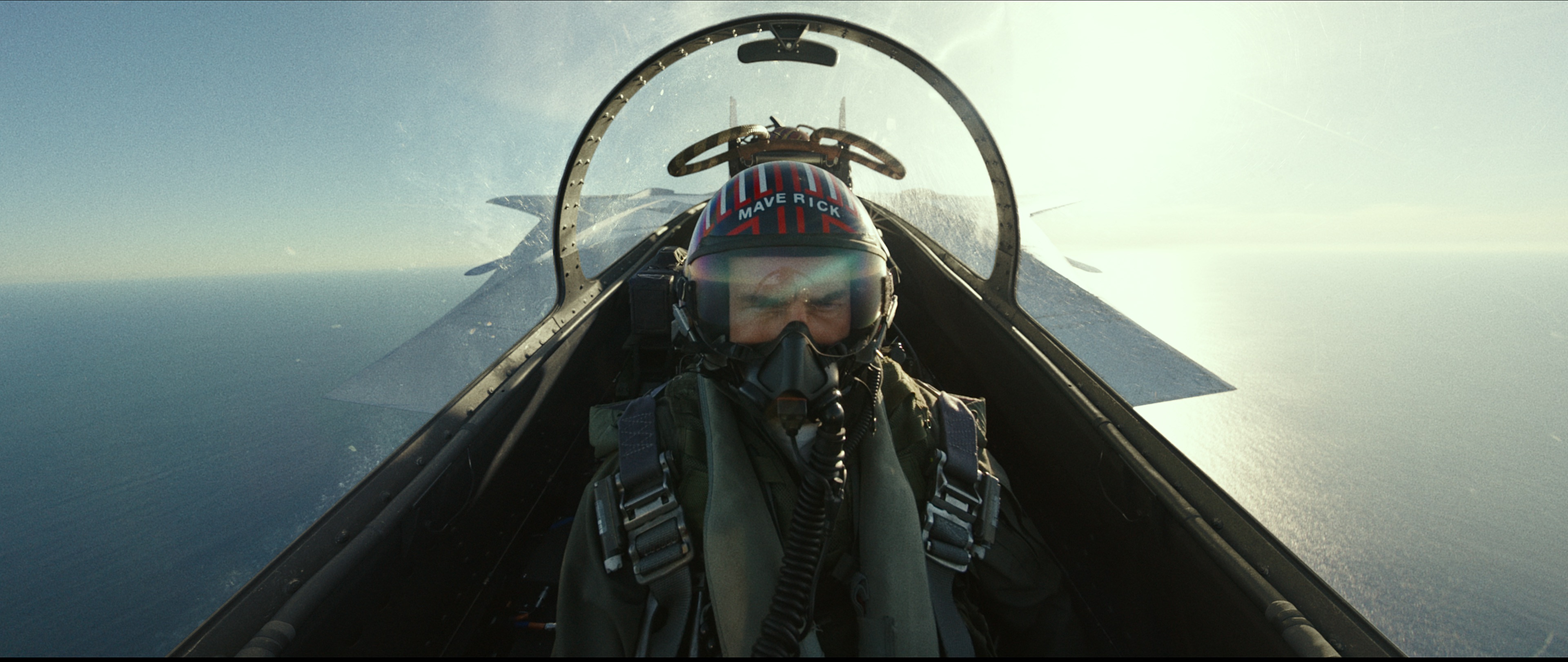Including that incredible camera-spinning oner.
Early on in Shang-Chi and the Legend of the Ten Rings, the brutal power of Xu Wenwu who has discovered the ten rings is revealed in a series of battle sequences. Method Studios in Melbourne contributed visual effects to the scenes, which included a mix of live-action and digital armies.
Visual effects supervisor Joshua Simmonds and CG supervisor Nathan Ortiz spoke to befores & afters about staging battle scenes, highlighting one moment when the camera spins around the battle action.
b&a: For the battles that involved horses and digi-double work, what could they film live action?
Joshua Simmonds (visual effects supervisor, Method Studios): Well, when we started, it was pre-COVID so we managed to get a good chunk of this sequence shot before the hiatus happened. We were shooting in [large park in Sydney called] Centennial Park for the majority of it. There was some open field work with the horses and with some of the soldiers, then we also had some infantry on-foot battles. This started out as a pine forest, but ended up being a fully snowy environment. We actually shot that on a 38 degree Sydney summer day. It had some dressing and some little snow drifts, but as the scene progressed, they decided they wanted to go more and more wintery until it was a complete winter wonderland with fog and full ground cover of snow, so it was quite a different environment by the time we finished it.


b&a: What was the build required?
Nathan Ortiz (CG supervisor, Method Studios): We had a conceptual phase where we talked about where it could be and created mood boards.
Joshua Simmonds: Yeah, a lot of it came down to the lighting. Over the course of a couple of days of shooting, you get cloud cover, you get bright sunshine, and you’ve got to try and find a way to weave it all together. Geographically, we were aiming for something around the Mongolian Steppes or the Kazakh Steppes where you’ve got grassland that goes up into mountains to give it a dramatic backdrop.
b&a: Were there any particular approaches you had to that environment work?
Joshua Simmonds: Our first step is gathering as much reference material as we can, not only of the actual geography itself, but also lighting studies. From that, we then start to rough it out with some basic shapes. We were using Gaea for most of our landscape generation. You block out the shapes, get it in a fairly happy place, and then you can weather it and get all those sort of erosion patterns forming, and then you can start to scatter.
Nathan Ortiz: It’s a mixture of Gaea, Houdini, a lot of scattering with V-Ray and our own custom proprietary tools. We actually had to create our own workflow, because it was lots of grass and shrubs that made up the bottom of the frame, and we wanted to be able to be close to it and it go into the distance.
Joshua Simmonds: We were hoping originally to keep as much grass from the plate in Centennial Park as we could, but it was all a bit too pristine. We did end up having to replace most of the grass in the immediate vicinity.



b&a: How did you then approach armies and horses and digi-doubles here?
Joshua Simmonds: We’ve developed our own library to some degree over time having been doing quite a lot of horse work. Still, you’re always going to be doing custom things and that’s where having footage that you can rotomate gives you a pretty good basis for the horses. In the end, the horses ended up being somewhat incidental to most of our crowd work. They ended up being quite ‘background’ after initially being the big ticket items. Most of the work came down to soldier animation.
Nathan Ortiz: For the soldiers, we had a Houdini system for crowds. It was used particularly for this one massive shot—a 360 degree shot that spins around several times where the soldiers get blown away by the rings. There were a lot of digital soldiers, all with cloth and the hair. We used Houdini’s rag doll simulation in the crowd system to get the base motion. Then, our anim TD happens to be the crowd programmer, as well. He made a tool that allowed us to convert the simulation data into proper anim rigs. That meant we could use our anim clothing—our full high-res clothing pipeline—to convert that to really high quality sims. We didn’t have to have a lower quality for crowd. They get really close to camera.
Joshua Simmonds: It also meant that we didn’t have to fully accept the raw simulation, either. We could then animate on top of it or repose it according to what we wanted, because rag dolls can often look very much just like rag dolls and you often want them to be flailing around a bit more or actually have some structural integrity.
b&a: Apart from what must have been huge challenges just to do that 360 shot in terms of the crowd, what were the toughest things to pull off there?
Joshua Simmonds: That one shot that Nathan was talking about—the shot number will be forever etched in my memory, I think—it effectively involved seeing the character riding in on his horse straight towards camera, and the camera is back with the Seljuk army, and he leaps off his horse, flies in the air, and he’s full CG through the flight, as is his horse as it turns. But then he lands pretty much smack bang in the middle of the front rows of this army, and then just proceeds to lay waste to them while the camera is spinning around him.
And it’s a pretty dusty environment so there’s lots of dust being kicked up. There are multiple elements that were shot of individual soldiers, plus there were probably three or four main takes that we had to stitch into a single, longer style shot. Just with all the chaos that’s happening in there, you’ve got to make sure that when you’re stitching it, 30 different soldiers don’t change positions too much. There’s a lot of, I’d say smoke and mirrors—probably dust and mirrors—going on through there just to help cover it all, and a couple of foreground soldiers that are well placed to help hide those transitions.
It ended up being quite a long shot. I think it was in production for close to a year, just on that one shot, that had its own compositing team just to bring it all together. You’re integrating so many layers with each other. You’ve got a consistent camera that has to be stitched so the background doesn’t jump around, the CG background, and then there’s the layers of ring effects and also the environmental effects the rings are causing and the dust kick-ups. It just ended up being a massive, massive shot for us. Probably one of the toughest ones I’ve worked on.



b&a: Is that a shot that started as a storyboard or early previs?
Joshua Simmonds: That one was very much driven by the stunt team with stuntvis. Destin, the director, was keen for a very naturalistic way of shooting the fights with long takes. His fight team were very experienced in setting up those kinds of choreography. Of course, they can shoot it in multiple takes, and make sure everyone’s safe, and get people on wires, but then because it’s multiple takes we have to work out how to stitch it all together. I was lucky enough to be there over a couple of days while this was being shot, helping out Joe Farrell, the Additional VFX Supervisor from Marvel who had spent a lot of time in pre-production for the sequence. There are so many moving parts to it and it’s so hard to keep track of where everybody is at any given time, especially when it’s 38 degrees and everyone’s hot and trying to escape to the shade as quickly as they can.
It went from stuntvis into a very early postvis after shooting the places. We were given the freedom to work out what was going to work from long takes of Quicktimes, and then once we found the selects that would work, we’d just call for those plates to be pulled so we could actually start working on the high res footage without it being hours and hours worth of EXR files.
b&a: What else in the battles proved to be a large challenge for Method?
Joshua Simmonds: We did have a lot of fun with the ring fight in the snow environment, as well. Actually, we were also involved in the ring power lookdev from quite early on. It started off with lots of big, bright kind of electrical elemental forces, but I think in the snow Destin was quite keen for us to get more of a sense of the power of the rings without it being telegraphed through all the bright glowy additive effects.
At one point, he swings a rope of rings around and it just kicks up this massive waft of snow which gave a sense of the shock wave that’s follows. Trying to get that realistic look to the snow, and the gravity, and the physics of that snow, in that shot was tricky, but fun.
Nathan Ortiz: That was a really complex snow sim. We’ve referenced a few things, snowboard kick ups, and explosions, or avalanches starting explosions. It’s like a big rooster tail of snow and mist.




b&a: For that kind of thing, is that something where you explicitly had any Marvel concept art or were you asked to try a few things out in Houdini or otherwise and see what happened?
Joshua Simmonds: I think we went through hundreds of versions in the early stages, and the hope was that we could pin something down before the shoot began. Marvel has done a bit of everything over the course of their catalogue of films, and Chris Townsend (Overall VFX Supervisor) was very keen to keep it in the family of Marvel, but wanted it to not really look like any other existing Marvel effect.
So, you’re constantly in a searching phase, trying to find the thing that’s just right. I think all vendors were working on it at the same time, and we all ended up having a slightly different look. In our case, when he was riding across the steppes towards the army, he’d swing his rings almost like whips that create this barrier against raining arrows that are coming against him. That was a very specific kind of effect just used for that one section. In many ways, the ring effects actually changed depending on the environment or the power that they were being used for at any given time.




























